We had just four players so Medina was the first out of the bag.
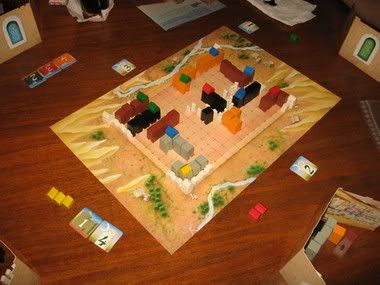
I first experienced arguably the best game from Stefan Dorra's catalog online on Brettspielwelt. Medina is intriguing in that it's the ultimate game of stalling, or what I call "negative timing" as players try to hold out and force opponents to cede the initiative on the board. It's got a feel akin to Reiner Knizia's Samurai, but taken to the extreme. Morgan Dontanville has called it as a game where he never wants to take his turn (he doesn't like Medina). I see it as a plus as players are forced to manage their resources in an unintuitive manner. Here, it's not HOW you spend it, it's WHEN you spend it. (And sometimes, IF you spend it at all.)
Then of course there are the bits. Sure, they could have used cardboard tiles, but the effect wouldn't be the same. This isn't a case of a game company stuffing low-utility eye candy plastic minis into a game just to increase marketability at the cost of functionality. Medina's wooden pieces help visualize the game and set the city features off from each other, which is important in a placement game such as this. People with big hands may have trouble sticking the little wooden men into the alleyways snaking through the city, but otherwise, the wooden pieces are a huge plus.
Anyway, we screwed up the most difficult rule in the game - taking control of the watchtowers by building walls adjacent to palaces. We played through with the incorrect rule, and will correct it on the next play. I had a decent lead through the midgame, but George took the negative timing of the game to heart and held out for a couple of large palaces. The Frog sacrificed a bit of time to deny everyone else the use of his palace blocks after he'd claimed palaces of those colors, but that cost him in the endgame as he "went out" the earliest. This decision led to his not having any towers to his name. All in all, everyone liked Medina and are looking forward to the next game.
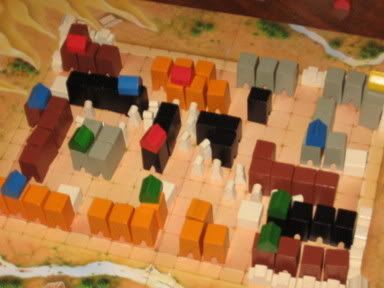
It was late that night so I proposed that I show the gang YINSH. Now I've played YINSH extensively on BSW but again this was the first time I was going to teach people the game with a physical copy. The Bakelite felt good, and The Frog picked up the rules quickly. Of course, this being a GIPF game experience counts. Even in YINSH, the most accessible of the series due to its fluid game states, having a few dozen games under one's belt leads to wins over newbies much more often than now. I left the game at the Lily Pad for the enjoyment of my hosts until the next weekend.
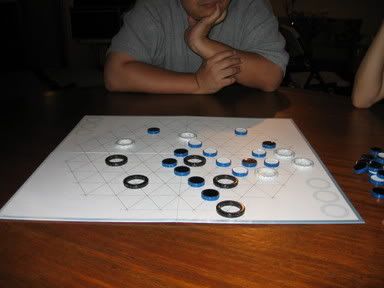
>>> FAST FORWARD ONE WEEK <<<
So, it was a week of lots of YINSH and lots of TAMSK. Over this period I grew to love TAMSK and as much as I enjoy YINSH, TAMSK is the best game in the Gipf series for me. The three-layered fourth dimension of time creates a game so unique that I could play a half-dozen games in a row and still be left wanting more. That's a first from an abstract for me.
For the unfamiliar - TAMSK is a game where player's pieces are three 3-minute hourglasses. These pieces move around on a hexagonal board, and when they move the players place a ring on the peg/space when the hourglass lands, and if a peg/space ever gets full up on rings it becomes illegal to move there. When an hourglass is moved, it is flipped. The object of the game is to use more rings than your opponent. If an hourglass ever runs out of time, it dies and becomes immobile. The last element is the 15-second "move glass" or what I've begun calling "the hammer" (because it drives the nail into your opponent's coffin if used correctly - i.e., brutally). You may flip the hammer to force your opponent to move before it runs out of time. If he fails to complete a move he begun, then you get to place a free ring. If he fails to move at all, he effectively passes and you go again.
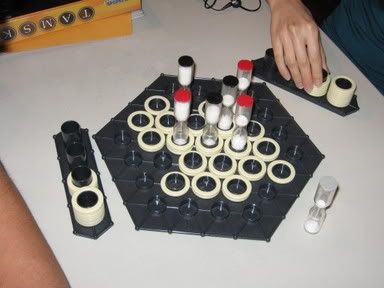
Try to use the hammer off-rhythm. Don't automatically flip it when your opponent's turn comes up. This forces him to pay attention to it, as he can't reliably determine how much time he has left to move if he doesn't. At the very least, it creates a distraction from the main board. At worst, it'll kill an hourglass or give you a free move.
Anyway, Erik was present for this gathering and we kicked the night off with several games of TAMSK and YINSH before dinner. A good time was had by all. Geroge and I won the TAMSK games. I also won the YINSH games I played.
After dinner, it was decided that it had been too long since we played Puerto Rico. Having four players, the opportunity was ripe so out came PR for its first appearance in 2006.
As usual, a brutal game with The Frog and I ending up with the Factories, and Erik and George scarfing up the Harbors. It was close through the midgame, and the Harbors were humming, but in the end the Frog picked up the win with great balance between shipping and the city, bolstered by the very deadly Guild Hall/Fortress combo.
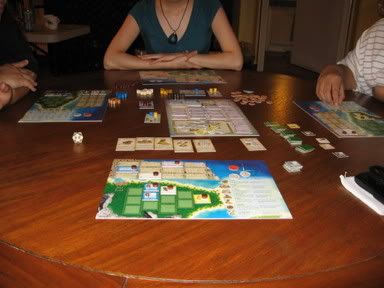
1 comment:
I like Spam.
Post a Comment